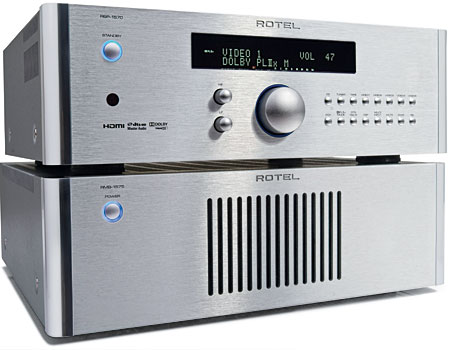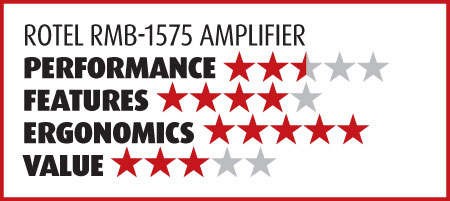Rotel RSP-1570 Surround Processor and RMB-1575 Amplifier Page 4
RMB-1575 Five-Channel Class D Amplifier
Clearly, Rotel’s goal was to introduce a surround processor and high-powered amplifier combo at the reasonable $5,000 price point. Back in 2006, Rotel introduced the $2,499 RMB-1077, a seven-channel Class D amp rated at 100 watts per channel that was packaged in a less impressively built chassis than the RMB-1575’s.

A few years later, the RMB1575 has more than double the rated power (250 watts per channel into 8 ohms, 500 into 4 ohms, all channels driven). It also features a far more rigid and attractive chassis, and five (not seven) channels for a scant $300 more than the RMB-1077. Like the RMB-1077, the RMB-1575 uses ICEpower amplifier modules, a Class D technology owned and licensed by Bang & Olufsen. The RMB-1575 is lightweight, powerful, efficient, and cool running. While Class D amplification is often called digital, it isn’t. Rotel’s Website claims that the RMB-1575 “excels at extracting all of the smallest audio details from both music and movie soundtracks.”
For an overview of how this basic technology operates, see Tom Norton’s description in his review of the RMB-1077 (UltimateAVMag.com/amplifiers/506rotel).
Tom’s review of that amp was positive even though he noticed a few areas where the amp was less than stellar at the frequency extremes. My review of the RMB-1575 won’t be as positive. At the risk of sounding like an irrational digiphobe, I know this isn’t a digital amp since there’s no A/D or D/A conversion. But I won’t mince words: I didn’t like the sound of this amplifier. I don’t consider it high fidelity. I don’t care what the measured power output ratings are or how well it measures in terms of noise and distortion. [It measured quite well, incidentally. See HT Labs Measures.—Ed.]

It wasn’t hard, it wasn’t bright or brittle or etched, but it didn’t sound right to me. My far more tolerant, non-techie wife liked it even less than I did. I watched the Jeff Beck at Ronnie Scott’s Blu-ray first with the Rotel amp and then switched to my more expensive reference Parasound Halo A51 class AB power amplifier (still with the Rotel RSP-1570 surround processor). I immediately admired the increased detail in drumming legend Vinnie Colaiuta’s cymbal work and snarecrack power, not to mention the string-bending subtleties in Beck’s playing. Beck pulls tiny textures and tonal shifts seemingly out of thin air. You can’t see him do anything, yet these subtle sonic shifts were easily audible with the Parasound in the system. It’s what gives the performance life and depth. The young Aussie gal bassist Tal Wilkenfeld is similarly astonishing as she works her way up and down the bass, pulling sophisticated textures from her fingering. You can hear the pressure she uses to press the strings to the fret board. Pulled together and reproduced skillfully, this disc delivers a trio playing in a small club that sounds remarkably lifelike in terms of timbre, spatiality, texture, and dynamics.
Understand that I’m exaggerating somewhat to make my point. Through the Halo amp, Colaiuta’s drum work was credibly reproduced. Through the RMB-1575, there was a soft, indefinable low-frequency blob purporting to be a bass drum, a limp snare, and excruciatingly ill-defined cymbals. If you just want to hear the noise, this amp is OK, but that’s not how I listen to music. My wife, who was half-listening from across the room, called the amp “bright,” but that wasn’t really the problem. The problem was that the attack was soft and ill defined, there was no definition in the sustain, and the decay lacked shape. With the RMB-1575, all of the cymbal hits seemed to swirl around in one large cloud of high-frequency haze. The more Colaiuta hit the cymbals, the more congested and unpleasant it seemed (but not “bright” in the traditional sense of the word). My wife said “bright” because the musical transients seemed ill defined, hung around too long, and didn’t know when to leave. When they piled up, the effect was a kind of brightness. Overall, it induced a gauzy seasickness instead of the pleasant, pulsing snap to attention that this hyper-rhythmic playing is intended to create.
The Orbison Blu-ray Disc was equally unsatisfying. I’m an Orbison fanatic. Through the RMB-1575, his vocals lost all of their timbral subtlety as he worked his way up and down his supernatural vocal range. When he duetted with Springsteen, the two voices washed together into a single mass. The three gals’ surround-channel vocals were shockingly unrecognizable.
Listened to casually, the amp was fine. It sounded smooth, there was no audible distortion, clipping, or compression, and I could crank it up without fear. Take a listen. If this amplifier’s sonic signature is your idea of what music sounds like, then more ICEpower to you. For me, I’ll take the sonic character of most Class AB amplifiers over this sound every time.

Conclusion
Most audio designers will tell you that low-level signal processing and amplification are far more difficult to get right than the high-powered variety. Here, Rotel does a superb job with low-level processing to produce a really attractive surround processor in almost every way. The attractive-looking, well-built, versatile, and very reasonably priced RSP-1570 sounded great, and I recommend it without hesitation.
As for the RMB-1575, I can’t help but feel that if you use these two products together, you’ll never hear all that the RSP-1570 has to offer. Rotel has always impressed me with its expertise, but this is a very different technology. Not surprisingly, it produces very different sonic results. I don’t care what the measurements indicate; this amplifier’s sound isn’t for me. You may feel otherwise, so go listen for yourself. But please pay attention to the finer aspects and nuance of music and movie reproduction before you plunk down your money.






























































